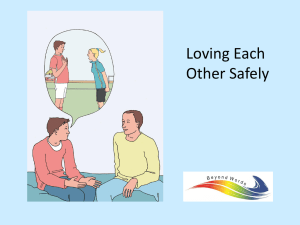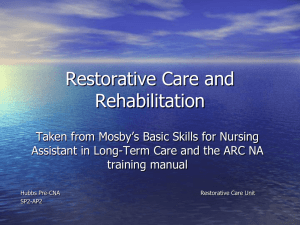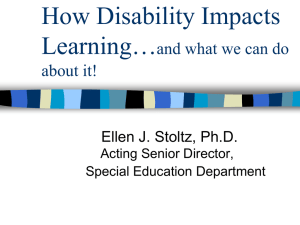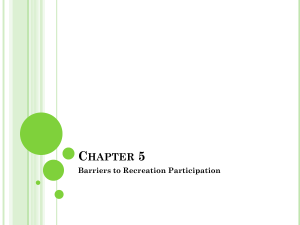Organizations working on Children
advertisement
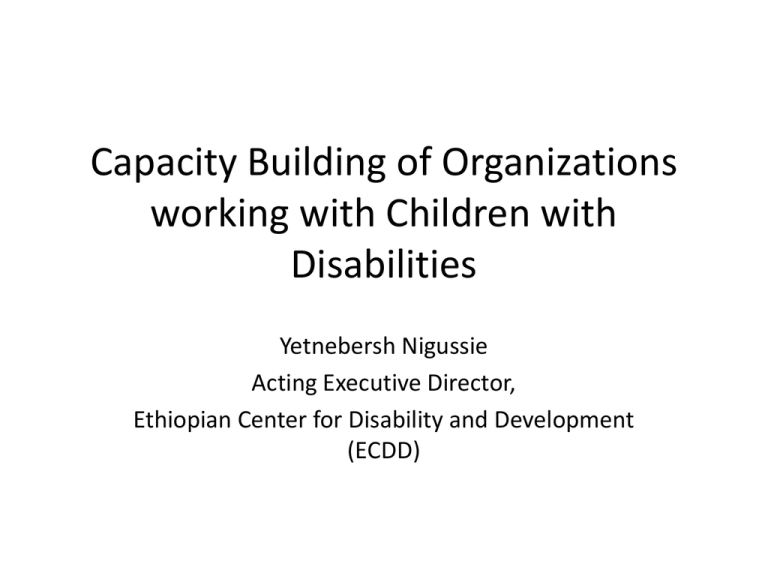
Capacity Building of Organizations working with Children with Disabilities Yetnebersh Nigussie Acting Executive Director, Ethiopian Center for Disability and Development (ECDD) Overview of Disability in Ethiopia • Rates of disability in the world are increasing due to population ageing and the global increase in chronic health conditions. • Currently, an estimated 15% of the world’s population, around 1 billion people with disabilities worldwide, represent 20 percent of the world’s poor (World Report on Disability, 2011 by WHO and World Bank) • About 80% of PWDs live in developing countries. • The 2007 Ethiopian census estimates that the prevalence of disability in Ethiopia is 1.09% but this result is widely believed to significantly underestimate the true figure. • Evidence from across the world indicates that people with disabilities and their families are more likely to experience economic and social disadvantage than those without disability. Children with Disabilities • Anecdotal evidence suggests that a low percentage of children with disabilities have had access to any education, traditional or modern, and due to their consequent lack of access to skills and education, are not seen in gainful employment once they become adults. • Lack of sign language skills and special needs training among teachers, and inadequate accessibility of schools and teaching materials, prevented disabled children from accessing education (Education for All Global Monitoring Report, 2010) • There aren’t many inclusive schools and those that exist do not teach disabled children (especially students with hearing and intellectual impairment) past Grade 5 (despite vocational training courses requiring a Grade 10 qualification); Children with Disabilities (Cont.) • the vast majority of inclusive schools are physically inaccessible (17% of children who had never been to school reported inaccessibility of nearby schools as a reason for not attending school)*; • a hugely inadequate number of teachers are being trained in special needs education (SNE); • Community Based Rehabilitation (CBR) program is central to access to education for children with disabilities. • However, many children do not have access to communitybased rehabilitation (CBR) (CSA 2008). * ACPF (2011) Children with disabilities in Ethiopia: The hidden reality. Addis Ababa, The African Child Policy Forum CBR • CBR is often interpreted differently around the world and means different things to different people. • While some people see CBR as service provision only, others see it more as an empowerment strategy. • CBR also differs in organization, structure, philosophy &scope. • The variety of programmes range from those that are basically health service oriented (medication, medical care, physiotherapy, rehabilitation), to those that are empowering (assistive devices, care and advice to children with disabilities and their families) based on human rights issues, sociopolitically oriented, and working within a social disability model. CBR (Cont.) • Ethiopia has a sizeable CBR sector, with at least one NGO present in almost all regions of the country. – Handicap national, – Cheshire Foundation Ethiopia and Cheshire Services Ethiopia – RAPID Adama, – Addis Development Vision and – Arba Minch Rehabilitation Centre • The principles and structure of CBR limit its contribution – – – – Early intervention is the major focus- focus mainly on young children It is time bound, but disability is not Capacity limitation Lack of integration with existing government programmes (e.g. HE program) Organizations working on Children with Disabilities • The issue of children with disabilities should be addressed because it is a human right issue and also the right thing to do so. • Not much has so far been done to address the challenges children with disabilities face. • There are basically two groups of organizations: – There are a number of organizations working on children – There are also organizations working on disability Organizations (cont.) • Organizations working on Children: — Although several NGOs work with children, few have the mechanisms in place to include and support disabled children. – These organizations oftentimes assume it is not their mandate to deal with children with disabilities – It is largely seen as a crosscutting issue- an excuse for failure to target this specific group – Have no inclusion strategies to address children with disabilities • Organizations working on disability: – Most are disabled persons organizations (DPOs0 and members of these organizations are persons with disabilities who are 18 and above years of age- Children as a result are often ignored – They often have other competing priorities (often issues related to young and adult persons with disabilities) Current Developments • • Ratification of the CRPDThe convention requires states to take all necessary measures to ensure the full enjoyment by children with disabilities of all human rights and fundamental freedoms on an equal basis with other children – – • Mainstream child focused organizations are working towards inclusion – – – • • • General Principle (Article 3) Standalone Article (Article 7) SAVE USA- trained its staff and working on disability inclusion strategy World Vision- promoting inclusion in funding Child Fund- employed disability inclusion specialist There are some disability specific schools like schools for the deaf and schools for the blind Positive moves in recent years in the promotion of inclusive education For example- Cheshire Services and Addis Development Vision (ADV)- are undertaking efforts on inclusive education. Basic Education Network (BEN) Ethiopia, through its members, also provided supports for children with different types of disabilities to help them learn in inclusive schools. Way forward • Having disability specific organizations alone will not solve the problem • Encouraging initiatives from donors to fund inclusive programs –USAID and World Vision • Inclusion has become one of the key requirements in RFAs • The solution to the problem is not merely building the capacities of disability specific organizations but promoting inclusion in mainstream organizations • Supporting the government structure to include disability in existing grassroots programmes Way forward • The first thing to note is that they are children regardless of their disability…so the existing mainstream organizations working on children should ensure the inclusion of children with disabilities in their programmes and activities_ this is a human right issue • Donors should require inclusion (USAID and World Vision are excellent examples) • So the future direction needs to be twin-track approach – Building the capacities of organizations/associations working on disability – Ensuring inclusion of children with disabilities in existing programmes or government and non-government organizations Thank you!




